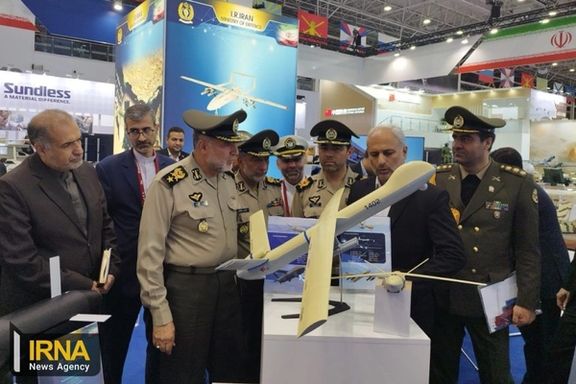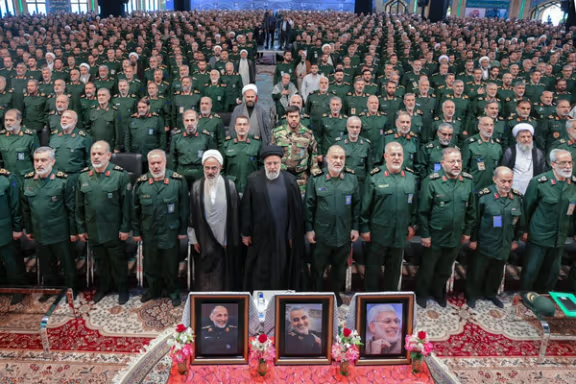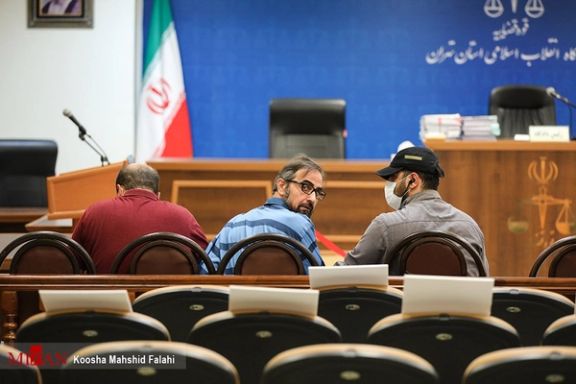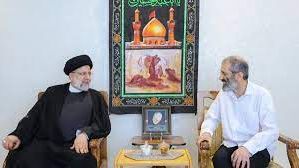Iranian Commander Visits Russia’s Army 2023 Expo

Iran’s Army Ground Forces Commander Kioumars Haydari has traveled to Moscow as Iranian-made drones are on display in a military exhibition.

Iran’s Army Ground Forces Commander Kioumars Haydari has traveled to Moscow as Iranian-made drones are on display in a military exhibition.
Invited by his Russian counterpart, Haydari is scheduled to visit several military technology and education centers as well as holding meetings with officials from the Russian armed forces and the Ministry of Defense.
Several other Iranian military officials have also visited Russia's annual Army International Military-Technical Forum which opened in Moscow last week. Iran’s delegation, led by Deputy Chief of Staff of Iran's Armed Forces, Aziz Nasirzadeh, has been a consistent presence at the event, dubbed Army 2023.
Last week, Russian Defense Minister Army General Sergey Shoigu also visited Iran’s military stand at the Army 2023 Forum, an event where Russia’s leading defense companies displayed some 1,500 of their products.
According to the Moscow Times, the event is an opportunity for Moscow to show off its "war trophies," Ukrainian and Western-made equipment captured on the battlefields of Ukraine.
Iran has previously denied allegations of sending armed drones to Russia during the conflict that ensued after Moscow's invasion of Ukraine. The Iranian government stated that any such shipments, if they did occur, took place before the war. However, Russia has used hundreds of these drones indicating recurring shipments.
Nevertheless, Russia's utilization of Iranian-made drones for attacks on Ukrainian infrastructure and civilian targets has drawn international criticism. Western powers have raised concerns over Iran's involvement in arming Russia with these drones, along with the possibility of supplying additional weaponry and ammunition.

Iran’s Revolutionary Guard has released a video of surveilling and following a US Navy ship in waters off the coast of the Strait of Hormuz in the Persian Gulf.
The incident of Iran’s military adventurism, which apparently occurred on August 17, was portrayed as a demonstration of the regime’s military control over the Persian Gulf's strategic waterway. This was showcased during a gathering of prominent IRGC commanders and officials in Tehran on Saturday.
In the video, IRGC Navy speedboats issued a warning to the USS Thomas Hudner warship and two of its helicopters seen flying above the vessel, not to violate Iran's territorial waters. Rear Admiral Alireza Tangsiri boasted about "the achievement," stating that the IRGC Navy compelled the intruding vessel to obey orders from the Iranian speedboats.

He elaborated that the IRGC deployed vessels from the Zolfaqar flotilla to the location where helicopters were approaching Iran’s territorial waters. In coordination with the speedboats, they pressured the choppers to land shortly after taking off from the vessel's flying deck.
The only thing clear in the video is that the IRGC navy issues its warning and the US warship replies that it is in international waters. A helicopter is seen landing on the deck but it is not clear if it took the actions because of an Iranian warning.
"Iran and other neighboring Persian Gulf countries can ensure regional security and they have no need to the presence of outsiders," he said, referring to more than 3,000 US sailors and marines that have arrived in the region along with the USS Bataan (LHD 50), an amphibious assault ship, and the USS Carter Hall (LSD 50), a dock landing ship.
The forces from the Bataan Amphibious Ready Group (ARG) and 26th Marine Expeditionary Unit (MEU) have been deployed in response to escalating tensions with Iran and as a show of maritime strength. In June, the Pentagon had already sent additional F-35 and F-16 fighter jets along with a warship to the Middle East in a bid to monitor key waterways in the region following Iran's seizure and harassment of commercial vessels.
The IRGC held drills around three Iranian islands in the Persian Gulf contested by the United Arab Emirates and claimed that it has added a 600-kilometer-range new missile to its arsenal “for defending the islands’ territory.”
Elsewhere in the Saturday event, Tangsiri said the IRGC Navy’s is especially vigilant in the face of threats from the warships of extra-regional countries.
Recent developments in the region, including Iran's seizure and harassment of vessels has seen tensions rising. Iran unveiled new maritime weaponry earlier this month and Washington offered commercial ships onboard armed protection through the Strait of Hormuz, which sees roughly one fifth of the world's crude oil travel out of the Persian Gulf. The US Navy's assertive posture also aligns with its efforts to reassure regional allies and maintain security in a volatile geopolitical landscape.
The deployment falls within the context of the US 5th Fleet's extensive area of operations, spanning approximately 2.5 million square miles and encompassing vital waterways like the Arabian Sea, Gulf of Oman, Red Sea, and critical choke points such as the Strait of Hormuz, Suez Canal, and Strait of Bab el-Mandeb.
Additionally, the Biden administration's efforts to address Iranian drone supplies to Russia have led to mounting pressure. The Defense Intelligence Agency's presentation of evidence demonstrating the Iranian origin of drones shot down over Ukraine highlights the administration's commitment to countering destabilizing activities.

A tanker seized by the US for carrying sanctioned Iranian crude oil has begun offloading its cargo despite Tehran’s threats against shipping shipping companies.
The Associated Press cited tanker-tracking data on Sunday that showed the oil cargo is being transferred from Marshall Islands-flagged Suez Rajan, a tanker anchored off the coast of Texas, near Galveston about 50 miles (80 km) from Houston.
The owners of the Suez Rajan, the Los Angeles-based private equity firm Oaktree Capital Management, did not immediately respond to requests for comment about the ship-to-ship transfer.
On Wednesday, a bipartisan group of US lawmakers from the House and Senate asked the Biden administration to respond to “unprecedented intimidation” tactics from Iran that have prevented American firms from offloading the confiscated oil cargo.
The US seized the Iranian oil onboard the ship late in May in accordance with US sanctions, but the oil had reportedly not been offloaded as US federal prosecutors have faced challenges in auctioning off the 800,000 barrels of oil. The lawmakers estimated the value of the oil to be $56 million.
According to the Wall Street Journal, the US companies are reluctant to unload the oil due to concerns about potential Iranian reprisals, particularly threats of violence by Iran’s Revolutionary Guards. Iran's IRGC navy commander Alireza Tangsiri warned in July that Tehran would retaliate against any oil company involved in unloading the Iranian oil.
The US Navy has increased its presence steadily in recent weeks in the Mideast, sending the troop-and-helicopter-carrying USS Bataan through the Strait of Hormuz in recent days and considering putting armed personnel on commercial ships traveling through the strait to stop Iran from seizing additional ships.

The UK Charity Commission has begun investigating an Iran-linked British foundation, which has hosted hardline Islamic clerics and paramilitary figures.
According to The Sunday Times, the watchdog, which regulates registered charities in UK, opened a compliance case into the Al-Tawheed Charitable Trust (TUCF), located in a repurposed Methodist church in Hammersmith, west London, which promotes Islamic Republic’s regime propaganda among Shia Muslim youth in the UK. The TUCF owns and operates the Kanoon Towhid and a student association.
The center claims to “relieve poverty and sickness of persons who profess the Islamic religion in the UK” but it mainly glorifies Ruhollah Khomeini, the founder and first Supreme Leader of the Islamic Republic who ruled until his death in 1989, and hosts events featuring figures affiliated with the regime.
On January 5, 2020, it hosted a packed event celebrating Qassem Soleimani, the commander of the IRGC’s Quds Force, an extraterritorial arm of the Revolutionary Guard, which oversees clandestine operations and supports terrorist groups such as Hezbollah. He had been killed in a US airstrike 48 hours earlier. The trust’s literature described him as a “great martyr”.
Several other events were held in the center with representatives of the regime delivering lectures, such as Seyyed Hashem Mousavi, a charity trustee described as the UK representative of Ali Khamenei.
The Jewish Chronicle reported that the center hosted an event last month in which an imam praised “martyrs” of the “axis of resistance” -- an Islamic Republic term meaning Tehran-backed regional militias who are “the greatest threat to the Zionists”.The Chronicle also linked the center to virtual and in-person talks by members of the IRGC.

Iran’s minister of intelligence Esmail Khatib said Sunday that secret services are holding “spies from Sweden, France and Britain,” referring to some Western hostages.
Without providing names or details about the detainees, the intelligence minister even claimed that despite foreign pressures some of the “spies have been executed.”
Iran executed Iranian-Swedish political activist and former leader of the Arab Struggle Movement for the Liberation of Ahwaz (ASMLA) Habib Chaab (Asyud) in May.
In January, Iran executed British-Iranian national Alireza Akbari, after sentencing the former Iranian deputy defense minister to death on charges of spying for Britain.
Khatib, who is a hardliner cleric, was addressing the 24th assembly of senior Revolutionary Guard officers in Tehran, where he praised Iran’s multiple intelligence services for working together to thwart “enemy conspiracies” and domestic threats.

Khatib reiterated the regime’s ideological precept that “the enemy” continues to plot against the Islamic Republic, which has become a “global power.” He claimed that “50 intelligence services” around the world have set up “Iran desks” to be able to confront “a new global power.”
The term “enemy” is a favorite word used by Iran’s ruler Ali Khamenei to refer to the United States, Israel and their allies and partners, but Khatib did not elaborate about who these 50 adversaries around the world are.
Although Iran has released several European high-profile hostages this year, including French and Belgian prisoners held on spying charges, it is not clear how many more are left behind.
French Foreign Minister Catherine Colonna, who spoke in May after the release of two French hostages, said more work is needed “because there are, unfortunately, too many who are detained without reason in Iran.” Apparently, four French citizens and numerous other Europeans remain incarcerated in Iran.
While intelligence minister Khatib boasted about holding European “spies” he did not mention the five American hostages who were released into house arrest earlier this month after a deal with the Biden administration to unblock $6 billion of Iran’s money in South Korea.
The deal has triggered a lot of criticism in the United States, where politicians and some analysts have voiced fear that essentially paying $1.2 billion per hostage will embolden the Islamic Republic and other adversaries to take Americans hostage. Iranian hardliners certainly see the deal as ransom payment by the United States.
A firebrand senior ayatollah, Ahmad Alamolhoda on Friday called the release of Iran’s frozen funds by the US “a humiliation” and a “ransom” in exchange for “their spies.” The cleric is close to Khamenei and is the father-in-law of President Ebrahim Raisi.
Khatib also reiterated that “the enemy’s” aim is to destabilize Iran and reduce participation in the upcoming parliamentary elections in March. The regime has blamed anti-government protests on US and Israeli plots, while it killed more than 500 civilians, injured thousands and has arrested around 22,000 since last September.
Regime politicians and many analysts in Iran believe that voter turnout will be low in March, simply because hardliners prevented other regime loyalists to run both in the 2020 parliamentary and in the 2021 presidential elections. People see no real choice and are deeply angered by the current economic and political crises. They do not believe that Khamenei will change his Anti-West foreign policy and sanctions will continue to increase hardships they face.

Iran's President Ebrahim Raisi has met with convicted terrorist Assadollah Assadi, who was released from Belgium in May in exchange for a Belgian hostage in Tehran.
A court in Belgium had sentenced Assadi to a 20-year prison term after being found guilty of involvement in a plot to orchestrate an attack on an Iranian opposition event in 2018 near Paris. However, he was released from prison and returned to Iran on May 26 as part of a mediated exchange carried out with the assistance of Oman.
In return for Assadi's release, Iran released Belgian aid worker Olivier Vandecasteele, who had been incarcerated in Tehran for nearly 15 months.
Despite the long trial in Belgium that led to Assadi's conviction, Iran claimed that he was innocent and treated him as a hero upon his return. Assadi was a diplomat in Iran's embassy in Austria and according to evidence submitted during his trial, he used his diplomatic status as a cover to organize the bomb plot.
The president's office reported on Saturday that during the meeting on Friday, President Raisi said, "The proponents of human rights have once again demonstrated their disregard for established legal frameworks." He further claimed that these countries “had violated international norms and principles” by undermining the diplomatic immunity of the Iranian diplomat.
The prisoner exchange marked the culmination of extensive political debates in Belgium, particularly within the nation's parliament. In January, Vandecasteele, aged 42, had been sentenced to 40 years in prison and 74 lashes on charges of "espionage," a verdict that both his family and Belgian authorities criticized as "unfair."
Since May, Oman-mediated negotiations have led to the release of six European citizens held in Iran, while several are still held hostage.